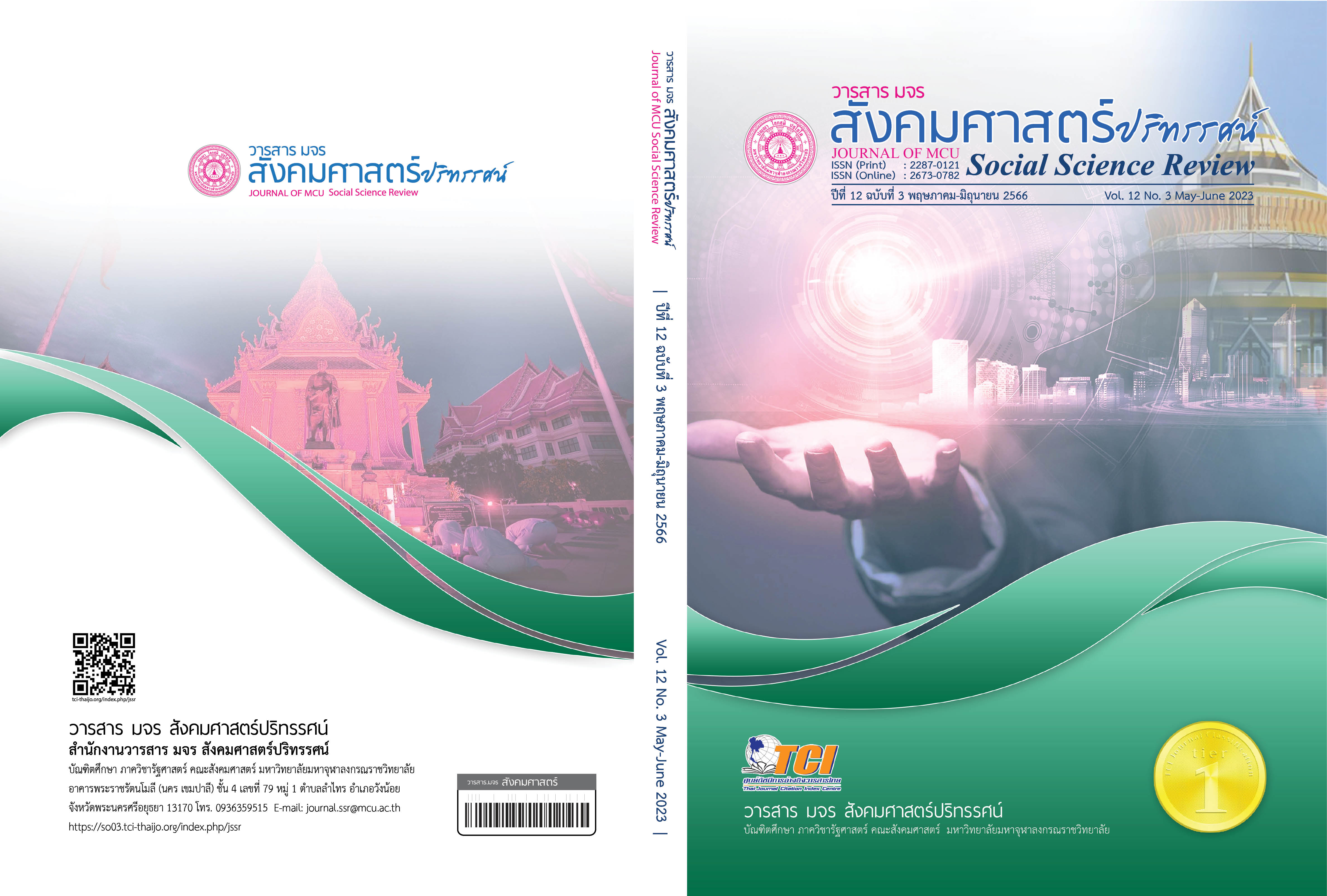กระบวนการมีส่วนร่วมของ บวร ในการจัดทำแผนเพื่อพัฒนาฐานวิถีชีวิตใหม่ ในพื้นที่จังหวัดกาญจนบุรี
คำสำคัญ:
กระบวนการการมีส่วนร่วม, แผนเพื่อพัฒนาฐานวิถีชีวิตใหม่, จังหวัดกาญจนบุรีบทคัดย่อ
บทความวิจัยนี้ มีวัตถุประสงค์ 1. การมีส่วนร่วมของพระสงฆ์ 2. รูปแบบการมีส่วนร่วม และ 3. วิเคราะห์กระบวนการมีส่วนร่วม เป็นงานวิจัยเชิงคุณภาพแบบลงภาคสนาม โดยการศึกษาเอกสารและการสัมภาษณ์เชิงลึก และทำกลุ่มสนทนา แบ่งกลุ่มผู้ให้ข้อมูลสำคัญเป็น 4 กลุ่ม คือ 1. กลุ่มพระสงฆ์วัดไชยชุมพลชนะสงคราม 2. กลุ่มตัวแทนนิสิต มจร. ห้องเรียนวัดไชยชุมพลชนะสงคราม 3. กลุ่มชาวบ้านผู้ได้รับผลกระทบจากวิกฤติโควิด-19 4. กลุ่มตัวแทนจากหน่วยงานที่เกี่ยวข้อง จำนวน 30 รูปหรือคน
ผลการศึกษาพบว่า 1. การมีส่วนร่วมของพระสงฆ์ มีสองระดับ ระดับแรกคือ ส่วนตัวพระสงฆ์ ระดับที่สองคือระดับองค์กรหรือวัด 2. หลักพุทธธรรมนำมาประยุกต์ใช้ คือ รู้ทันความกลัวและหยุดด้วยหลักพุทธศาสนา พัฒนาฐานวิถีชีวิตใหม่อย่างยั่งยืนตามหลักปธาน 4 และ พัฒนาฐานวิถีชีวิตใหม่อย่างยั่งยืนตามหลักภาวนา 4 ภายใต้สุขภาวะทางสังคมที่มุ่งไปสู่การพัฒนาด้านกาย จิต ปัญญา และสังคม 3. กระบวนการมีส่วนร่วมด้วย หลัก 5 ผ ได้แก่ 1 แผนดีมีผู้นำ ผู้นำเป็นที่น่าเคารพ เลื่อมใสศรัทธา 2 แผนนั้นบำเพ็ญด้วยจิตอาสา ทุกคนในชุมชน มีความเสียสละ มุ่งมั่น มีจิตอาสาร่วมกันดำเนินโครงการให้ประสบความสำเร็จ 3 แผนชวนสานเสวนา ร่วมกันพูดคุยระหว่างตัวแทนจาก บ้าน วัด โรงเรียนหน่วยงานราชการ หาปัญหาและสาเหตุของผู้ได้รับผลกระทบ นำเสนอแนวทางแก้ไข 4 แผนบูรณาการสานสัมพันธ์ ร่วมแรงร่วมใจให้ความสำคัญกับการทำงานสร้างความสัมพันธ์ที่ดี พร้อมให้ความช่วยเหลือ สนับสนุนประสานงานระหว่างบ้าน วัด โรงเรียนหรือหน่วยราชการ 5 แผนบริหารสู่ความยั่งยืน ร่วมกันทำตามเป้าหมายแผนงาน ในการจัดตั้งคณะกรรมการดำเนินงาน
เอกสารอ้างอิง
พระครูสมุห์วรวิทย์ ผาสุโก. (2559). พระสงฆ์กับการเสริมสร้างความเข้มแข็งของชุมชน: กรณีศึกษาชุมชนวัดสามชุกฝั่งตะวันตก และฝั่งตะวันออก. วารสารสันติศึกษาปริทรรศน์มจร, 4(ฉบับพิเศษ), 270-283.
พระณัฐวุฒิ พันทะลี, บทบาทของพระสงฆ์กับการช่วยเหลือประชาชนในสถานการณ์โควิด-19, วารสารวิชาการแสงอิสาน, 17(1), 66-76.
พระเทพปริยัติโสภณ (ปัญญา วิสุทฺธิปญฺโญ). (2563, 1 มิถุนายน). เจ้าคณะจังหวัดกาญจนบุรี และเจ้าอาวาสวัดไชยชุมพลชนะสงคราม พระอารามหลวง (วัดใต้). [บทสัมภาษณ์].
พระครูวิลาศกาญจนธรรม (เล็ก สุธมฺมปญฺโญ). (2563, 1 มิถุนายน). เจ้าอาวาสวัดท่าขนุน อำเภอทองผาภูมิ จังหวัดกาญจนบุรี. [บทสัมภาษณ์].
สำนักงานคณะกรรมการสุขภาพแห่งชาติ, ธรรมนูญสงฆ์ รวมพลังชุมชน พระ วัดทั่วไทย ต้านภัยโควิด 19. สืบค้น 1 มิถุนายน 2563, จาก, www.nationalhealth.or.th/node/3093.
พระเมธาวินัยรส (สุเทพ พุทธจรรยา). (2564). การเมืองภาคพลเมือง: การมีส่วนร่วมทางการเมืองในระบอบประชาธิปไตย, วารสารสหวิทยาการนวัตกรรมปริทรรศน์, 3(2), 67-72
พระเอกลักษณ์ อชิโต และคณะ. (2564). เครือข่ายพระสงฆ์สาธารณะสงเคราะห์ของหลวงพ่อแดง นนฺทิโย: กับการช่วยเหลือประชาชนในพื้นที่น้ําท่วมซ้ําซ้อน จังหวัดสุโขทัย. วารสารสหวิทยาการนวัตกรรมปริทรรศน์, 4(1), 88-101.
ดาวน์โหลด
เผยแพร่แล้ว
รูปแบบการอ้างอิง
ฉบับ
ประเภทบทความ
สัญญาอนุญาต
ลิขสิทธิ์ (c) 2023 วารสาร มจร สังคมศาสตร์ปริทรรศน์

อนุญาตภายใต้เงื่อนไข Creative Commons Attribution-NonCommercial-NoDerivatives 4.0 International License.
เพื่อให้เป็นไปตามกฎหมายลิขสิทธิ์ ผู้นิพนธ์ทุกท่านต้องลงลายมือชื่อในแบบฟอร์มใบมอบลิขสิทธิ์บทความให้แก่วารสารฯ พร้อมกับบทความต้นฉบับที่ได้แก้ไขครั้งสุดท้าย นอกจากนี้ ผู้นิพนธ์ทุกท่านต้องยืนยันว่าบทความต้นฉบับที่ส่งมาตีพิมพ์นั้น ได้ส่งมาตีพิมพ์เฉพาะในวารสาร มจร สังคมศาสตร์ปริทรรศน์ เพียงแห่งเดียวเท่านั้น หากมีการใช้ภาพหรือตารางหรือเนื้อหาอื่นๆ ของผู้นิพนธ์อื่นที่ปรากฏในสิ่งตีพิมพ์อื่นมาแล้ว ผู้นิพนธ์ต้องขออนุญาตเจ้าของลิขสิทธิ์ก่อน พร้อมทั้งแสดงหนังสือที่ได้รับการยินยอมต่อบรรณาธิการ ก่อนที่บทความจะได้รับการตีพิมพ์ หากไม่เป็นไปตามข้อกำหนดเบื้องต้น ทางวารสารจะถอดบทความของท่านออกโดยไม่มีข้อยกเว้นใดๆ ทั้งสิ้น





